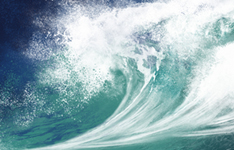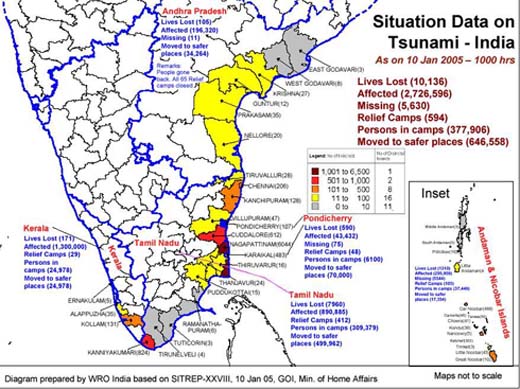Natural Disaster : Tsunami
What is Tsunami?
A tsunami is a series of water waves caused by the displacement of a large volume
of a body of water, typically an ocean or a large lake. Earthquakes, volcanic eruptions
and other underwater explosions (including detonations of underwater nuclear devices),
landslides, glacier calvings, meteorite impacts and other disturbances above or
below water all have the potential to generate a tsunami. Tsunami waves do not resemble
normal sea waves, because their wavelength is far longer. Rather than appearing
as a breaking wave, a tsunami may instead initially resemble a rapidly rising tide,
and for this reason they are often referred to as tidal waves. Tsunamis generally
consist of a series of waves with periods ranging from minutes to hours, arriving
in a so-called "wave train".Wave heights of tens of metres can be generated by large
events. Although the impact of tsunamis is limited to coastal areas, their destructive
power can be enormous and they can affect entire ocean basins; the 2004 Indian Ocean
tsunami was among the deadliest natural disasters in human history with over 230,000
people killed in 14 countries bordering the Indian Ocean.

The principal generation mechanism (or cause) of a tsunami is the displacement of
a substantial volume of water or perturbation of the sea. This displacement of water
is usually attributed to either earthquakes, landslides, volcanic eruptions, glacier
calvings or more rarely by meteorites and nuclear tests.The waves formed in this
way are then sustained by gravity. Tides do not play any part in the generation
of tsunamis.
Tsunami generated by seismicity
Tsunami can be generated when the sea floor abruptly deforms and vertically displaces
the overlying water. Tectonic earthquakes are a particular kind of earthquake that
are associated with the Earth's crustal deformation; when these earthquakes occur
beneath the sea, the water above the deformed area is displaced from its equilibrium
position.More specifically, a tsunami can be generated when thrust faults associated
with convergent or destructive plate boundaries move abruptly, resulting in water
displacement, owing to the vertical component of movement involved. Movement on
normal faults will also cause displacement of the seabed, but the size of the largest
of such events is normally too small to give rise to a significant tsunami.

Drawing of tectonic plate boundary before earthquake

Overriding plate bulges under strain, causing tectonic uplift.

Plate slips, causing subsidence and releasing energy into water.

The energy released produces tsunami waves.
Tsunami Characteristics
Tsunamis cause damage by two mechanisms: the smashing force of a wall of water travelling
at high speed, and the destructive power of a large volume of water draining off
the land and carrying all with it, even if the wave did not look large.
While everyday wind waves have a wavelength (from crest to crest) of about 100 metres
(330 ft) and a height of roughly 2 metres (6.6 ft), a tsunami in the deep ocean
has a wavelength of about 200 kilometres (120 mi). Such a wave travels at well over
800 kilometres per hour (500 mph), but owing to the enormous wavelength the wave
oscillation at any given point takes 20 or 30 minutes to complete a cycle and has
an amplitude of only about 1 metre (3.3 ft).This makes tsunamis difficult to detect
over deep water, where ships are unable to feel their passage.
As tAs the tsunami approaches the coast and the waters become shallow, wave shoaling
compresses the wave and its speed decreases below 80 kilometres per hour (50 mph).
Its wavelength diminishes to less than 20 kilometres (12 mi) and its amplitude grows
enormously. Since the wave still has the same very long period, the tsunami may
take minutes to reach full height. Except for the very largest tsunamis, the approaching
wave does not break, but rather appears like a fast-moving tidal bore.Open bays
and coastlines adjacent to very deep water may shape the tsunami further into a
step-like wave with a steep-breaking front.
Map of Tsunami Affected Areas in India
